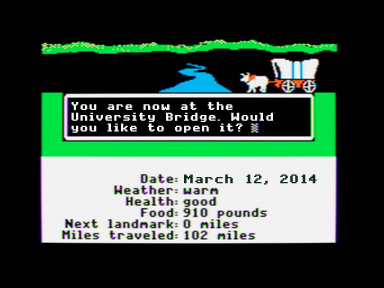
As you waited on the deck of the University Bridge, staring out at Portage Bay as a tall vessel passed through the open bridge deck, you probably did not spend any time thinking about the computer system that helps operate the bridge openings. But if you had, you probably would have assumed there were sophisticated systems at work.
You would have been wrong.
It turns out, the bridge operates in part using a Compaq 8080 running MS-DOS and using 5.25″ floppy disks, the Seattle Times reports.
Well, this week, the city is updating the bridge’s electronic systems, including hundreds of wires, circuits and, yes, the trusty Compaq. Due to the work, bridge openings may last ten minutes instead of the normal five. So be prepared for some extra wait time.
Maybe if you ask nicely, the bridge operator will let you inside for a quick game of Oregon Trail while you wait.









Comments
21 responses to “No more 5.25″ floppy disks: University Bridge openings will take longer as city updates computer, wiring”
Now you tell me! ;)
I was stuck in that mess, last Monday afternoon…
When a ship approaches, you run Raise.bat, eh?
The white-bearded guy I talk to in the mirror tells me DOS and 8080s are sophisticated. Now where did I put the darn razor?
Picturesque opening sentence, but as someone whose been waiting on my bike for the University Bridge to lower since third grade (no, not continuously!) I must point out that there is no view of Lake Washington from the University Bridge. (Unless you’re about forty feet tall…)
Portage Bay on one side, Lake Union on the other.
You got me. :-)
I’m never going to win the All Ages and Abilities as appropriate standard for cycling facilities fight here (I’m not sure that’s a standard we should be striving for…) (which I recognize is a little ironic because I really did bike form Capitol Hill to the U District all the time as a kid) but at least I get a couple geographical nerdiness points.
Keep up the good and much needed work, and thanks!
5 1/4 inch drives. Mike Lindblom is conflating two drive types.
Man, I’m getting all kinds of details wrong today. Fixed it!
Another detail might probably be that the Compaq machine is a 8088 or 8086. Since MS-DOS is a 16 bit Operating System it never ran on the 8080 CPU. So assuming 8080 is not a historic Compaq model designation (I couldn’t find it) that might need to be changed as well. ;)
I have yet a few 5 1/4 floppies here : http://imgur.com/cw4wq9O
You may say these systems aren’t “sophisticated” but let’s all remember that these systems lasted all these years until today.
I believe that in itself is a major feat!
[…] bridge in Seattle still operates on a 1980s Compaq 8080 running MS-DOS and using 5.25″ floppy disks but is upgrading this […]
If you need 5.25″ disk drives or floppy disks, let me know. I’ve new ones ready for your use.
You assumed wrong Tom. I assumed raising and lowering the bridge involved a large ratcheting lever and gears. I’m a little shocked to hear that computers were even involved. I honestly wouldn’t have been a bit surprised if you told me a hamster wheel was involved.
Ha!
Rather than update (given that the system has been working pretty well for decades), they could replace it with a $35 Raspberry Pi and emulate the whole old PC (drives and all) via DOSBox…
And this is why COBOL still exists to this day.
People would be very surprised that this is the norm more than not.
Quite simply, The “benefit” to “upgrading” such control computer systems is usually a negative:
1. The new systems OS may not work with the old code.
2. The old system was perfectly functional. A computer that controls a bridge does NOT :
a. need to be faster (the bridge is slow after all),
b. internet capable – so it can get hacked?
3. reliability is the most important aspect of any system. New components / software means testing esp. for something that can cause injury or death if there is a failure.
If it’s a Compaq, it’s an 8086, not an 8080. Compaq never made any 8080s, and MS/DOS doesn’t run on them.
Other than the floppy, maybe, it’s pretty reliable stuff, as evidence shows.
I guess my old-time geek is showing, but I’ll join the chorus.. 8080 mostly ran CP/M, and never ran MS-DOS.
You have died of dysentery (waiting for the University Bridge).